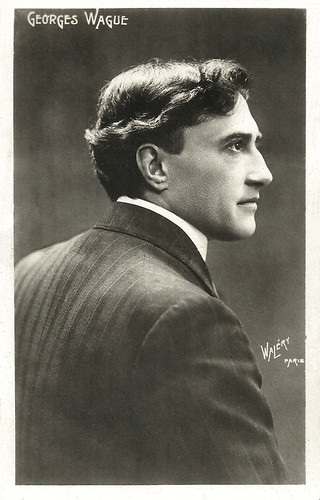
French postcard. Photo Waléry, Paris.
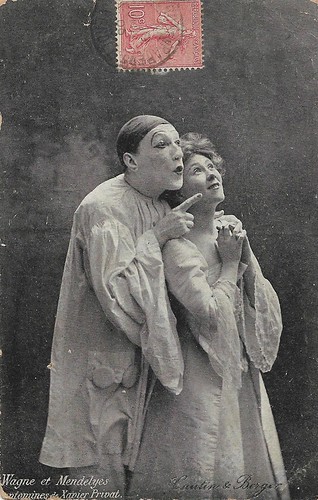
French postcard by Cautin & Berger, ca. 1900, mailed July 1905. Georges Wagne [sic, = Wague] and Mendelyes [sic, = Christiane Mendelys, aka Christiane Wague]. Caption: Cantomines [sic, = cantomimes] de Xavier Privat [sic, = Privas].

French postcard. Photo: Waléry, Paris. Georges Wague and Colette Willy in La Chair (The Flesh, 1907) written by Georges Wague and Leon Lambert, with music by Albert Chantrier. It was Colette's greatest stage success.
The invention of the Cantomime
Georges Wague was born Georges Marie Valentin Waag in Paris in 1874. His parents were strict and devout. His mother died when he was nine, and he was placed in l’école des Frères de la doctrine chrétienne (the school of the Brothers of the Christian doctrine) in Paris. Here he helped with performances given by the association of young people from the parish of Saint-Sulpice and began to recite poetry with this association. He qualified as an electrical engineer before entering the Conservatory of Dramatic Art of Paris as an auditor. At the Conservatory he attended the course given by Dupont Vernon.
In the early 1890s, Wague participated in the soirées of La Plume, the literary magazine founded by Léon Deschamps, where he was noticed for his verse recitals. Xavier Privas proposed to sing songs while Georges Wague mimed them, creating a new artistic expression they called 'Cantomime'. Cantomime from "canto" (singing) and mime. In the cantomimes, which began in 1893 at the Café Procope, Wague performed on stage with a singer and piano in the wings. Often the character was Pierrot. The established mime Félicia Mallet assisted Wague in developing his highly individual style during the early part of his career. He moved to the Bodinière theatre where he became known in Paris with his cantomimes including 'Noël de Pierrot' (1894) and 'Le Testament de Pierrot' (1895).
Wague first staged his pantomime at the Théâtre Montparnasse in 1895, 'Le Voeu de Musette'. Many others followed over the years. To revive his career after his return from military service in 1898, Georges Wague began to participate in soirées of the 'Veillées artistiques de Plaisance'. Cantomimes included 'Pierrot Chante' (1899) and 'Sommeil Blanc' (1899). 'Sommeil Blanc' (White Sleep) was written for him by Xavier Privas, with music by Louis Huvey.
Due to rivalry with other performers of cantomimes, Wague created a company with Christiane Mandelys (or Mendelys), who became his wife, to preserve his rights as the inventor of the concept. With his troupe, he played 'La Roulotte' (The Caravan) directed by Georges Chartron. He won success and began touring in France and abroad, leading to the presentation of the last show at the Exposition Universelle (1900) where he played several Pierrot plays including 'Pierrot infidèle' (Unfaithful Pierrot) and 'Le Noël de Pierrot' (Christmas Pierrot).
George Wague decided to move from white pantomime, in which gestures and movements were ample, to dramatic pantomime. To do this, he changed his stage acting: his mime consisted of gestures reduced to the simplest attitudes to express the full range of thought in constant movement. He did not use the conventional alphabet of mimes in this original form of expression.

French postcard by Editions artistique de Walery. Photo: Walery, Paris. Publicity still for the play Giska la Bohémienne (1908) by Ed. Leroy.
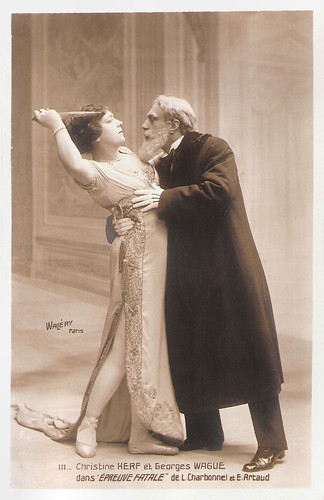
French postcard by Editions artistique de Walery. Photo: Walery, Paris. Georges Wague and Christine Kerf in the play 'Épreuve Fatale' (1913) by Leon Charbonnel and Emile Artaud.
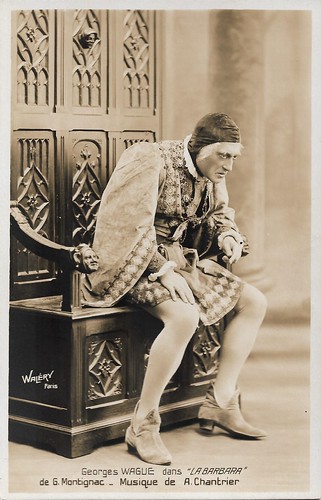
Vintage French postcard. Photo by Waléry, Paris. Georges Wague in the lead of the play 'La Barbara' by G. Montignac and Wague, music by A. Chantrier, performed e.g. in June 1913 at the Ba-Ta-Clan in Paris.
Colette and La Argentina
Georges Wague taught pantomime, notably to the writer Colette, with whom he made a tour from 1906 to 1912 and caused a scandal with presentations of 'La Chair' (The Flesh) where Colette performed largely naked.
Wague performed in many other stage pantomimes including 'Scaramouche', 'Barbe Bluette' and 'L'homme aux poupées', and played silent roles in ballet and opera. He continued to play a white-faced Pierrot at the Opéra-Comique during the 1920s.
From 1916 Wague taught at the Conservatoire national supérieur d'art dramatique. Wague taught mimes who went on the fame such as Christine Kerf, Caroline Otéro, Angèle Héraud and Charlotte Wiehé. In 1920, he and his wife Christiane Mandelys opened a mime and comedy school in their home on rue Pigalle. He also taught actors and opera singers how to use their bodies to express their feelings. This skill was much neglected in opera, where often the singers were chosen for their voice rather than their appearance and had little acting ability.
In 1925 he performed with the flamenco dancer Antonia Mercé y Luque, "La Argentina", in 'El amor brujo' at the Théâtre Trianon-Lyrique. Later, Wague collaborated with the mime and actor Jean-Louis Barrault when he played Jean-Gaspard Deburau in the classic film Les Enfants du Paradis/Children of Paradise (Marcel Carné, 1943), the basis for his 1946 mime piece 'Baptiste'.
After the death of his wife, Christiane Mandelys, in 1957, he collected his archives and deposited them in the Bibliothèque Nationale. Georges Wague was awarded the 'Grande médaille de vermeil' by the city of Paris in 1962. In 1965, Wague died at Menton in the Alpes-Maritimes, aged 91.

French postcard. Photo: Waléry, Paris. Georges Wague and Marietta Ricotti in 'L'Aragonaise' by A. Gailhard. L'Aragonaise was a pantomime by Wague, with songs by Gailhard/Gaillard. Ricotti was a singer from the Paris Opera.

French postcard by R. Guilleminot, Boespflug et Cie., Paris. Georges Wague is misspelt on the card as Georges Vague.
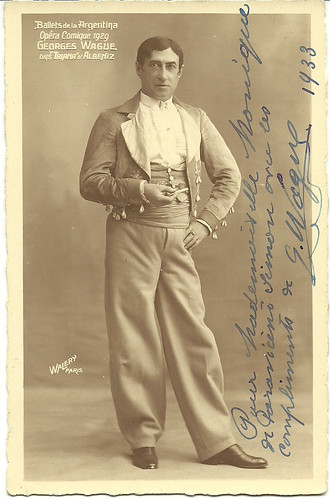
French postcard by Walery, Paris, 1929. Photo: Walery, Paris. Publicity still for the Ballets Argentina / Operas Comique production of Triana by Albeniz. Collection: Didier Hanson.

British postcard by K Ltd.
Source: Wikipedia (English and French) and IMDb. See also Tami Williams, 'The “Silent” Arts. Modern Pantomime and the Making of an Art Cinema in Belle Époque Paris: The Case of Georges Wague and Germaine Dulac', in A Companion to Early Cinema (2012).
No comments:
Post a Comment